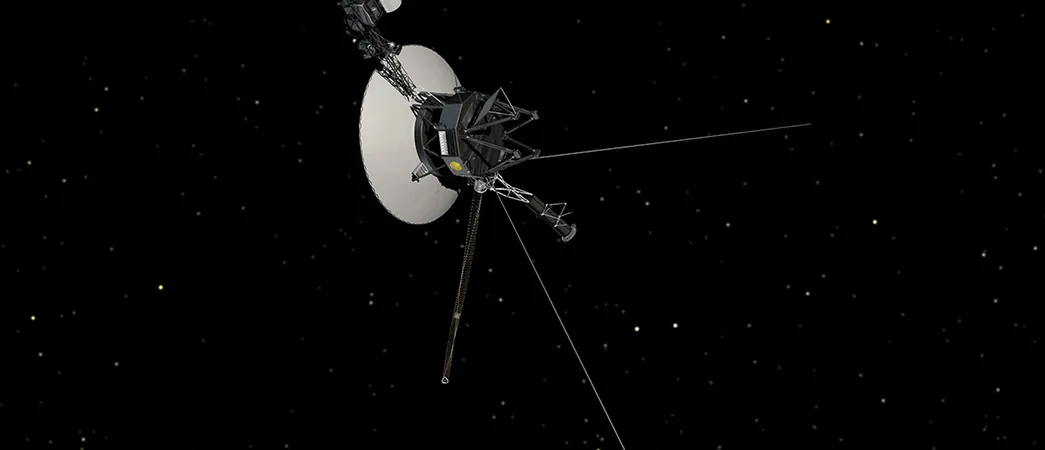
Voyager 1 Faces Communication Challenges Amidst Aging Technology: What’s Next for the Iconic Space Probe?
2024-11-03
Author: Arjun
Communication Issues with Voyager 1
Voyager 1, the pioneering NASA spacecraft launched on September 5, 1977, has made headlines again as it encounters communication issues due to its aging technology. In an impressive feat of engineering, Voyager 1 has been transmitting data back to Earth for over four decades, yet it is not without challenges. In a startling turn of events, NASA was forced to shut down one of Voyager 1's radio transmitters earlier this week, leaving it with only its low-power transmitter for communication.
Mission Overview and Achievements
Originally, Voyager 1's mission was to explore the outer planets, focusing on remarkable flybys of Jupiter and Saturn, allowing us to capture spectacular images and gather invaluable data. In 2012, the craft achieved a historic milestone by becoming the first human-made object to enter interstellar space, crossing the heliopause—the point where solar wind from the Sun slows down and eventually ceases. As it continues to journey more than 22 billion kilometers from Earth, Voyager 1 provides crucial insights into the interstellar medium, deepening our understanding of space.
Operational Hiccups
However, as time passes, operational hiccups are to be expected. Just recently, on October 24, NASA had to reconnect with Voyager 1 after discovering that one of its radio transmitters was offline. While the prospect of alien intervention might sound thrilling, the truth is far less sensational. The transmitter was disabled due to an onboard fault protection system, which ensures the spacecraft remains functional even when issues arise. If Voyager 1 draws too much power, these systems kick in to shut down non-essential operations to preserve power and avoid damages.
Communication Complexity
Communicating with Voyager 1 is a complicated endeavor, as signals travel at the speed of light and the immense distance means signals take nearly 23 hours to reach or return from the spacecraft. A single command request may result in a 46-hour delay for feedback, making troubleshooting a painstaking process. On October 16, ground engineers sent a command to activate a heater on board the probe. However, the command inadvertently triggered a shutdown of the radio transmitter to conserve power.
Monitoring the Situation
The lack of expected signals was first noticed on October 18, when the Deep Space Network could not detect the usual pings from Voyager 1. Fortunately, engineers discovered that the spacecraft was communicating using a backup radio transmitter, one that hadn’t been used since the 1980s! Although the fault was identified, the engineering team opted not to immediately switch back to the primary transmitter to prevent further occurrences of the issue. They are carefully analyzing the situation to better understand the fault before making any adjustments.
Voyager's Legacy and Future
As Voyager 1 continues its incredible odyssey through the cosmos, the team at NASA remains committed to maintaining communication with Earth, even if that now relies on a lower power transmitter. This remarkable spacecraft serves not only as a scientific instrument but also as a time capsule, carrying the "Golden Record," a collection of sounds and images representing life on Earth, intended for any extraterrestrial beings that might one day find it.
Conclusion
As Voyager presses onward, its journey serves as an inspiring reminder of human ingenuity and the relentless pursuit of knowledge about our universe—even as the technology that makes it possible continues to age. What other secrets might Voyager uncover as it ventures further into the unknown? Stay tuned to follow the fascinating updates on this interstellar trailblazer!

 Brasil (PT)
Brasil (PT)
 Canada (EN)
Canada (EN)
 Chile (ES)
Chile (ES)
 España (ES)
España (ES)
 France (FR)
France (FR)
 Hong Kong (EN)
Hong Kong (EN)
 Italia (IT)
Italia (IT)
 日本 (JA)
日本 (JA)
 Magyarország (HU)
Magyarország (HU)
 Norge (NO)
Norge (NO)
 Polska (PL)
Polska (PL)
 Schweiz (DE)
Schweiz (DE)
 Singapore (EN)
Singapore (EN)
 Sverige (SV)
Sverige (SV)
 Suomi (FI)
Suomi (FI)
 Türkiye (TR)
Türkiye (TR)